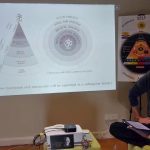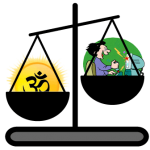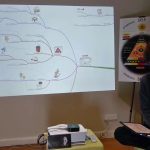How To Apply Knowledge of Vedanta in Daily Life?

Understanding the Core Obstacle
The biggest obstacle to effortlessly and permanently enjoying your true nature as Brahman (awareness) — is the identity of self is intimately mixed-up with your body-mind instrument.
Even after understanding what the shruti (Scriptures) teach — the orientation that “I am as good as the limitations of this body-mind” still remains.
It's true that there is a body-mind because of past karmas (actions), however your identity is much vaster.
It is your ignorance that's causing you to take self to be a kartā (doer) and bhoktā (experiencer).
This kartṛtva bhoktṛtva buddhi (doer-enjoyer identification) has to be given up.
The Deep-Rooted Misidentification
This thought of association with the body-mind-sense complex is very deep and is a samskara (impression) carried on from birth to birth. This wrong identification needs to be given up.
Vedantic knowledge erases this wrong identification error.
The Purpose of Contemplation
Contemplation helps to uproot this wrong idea from the mind of the seeker. It is not a means for getting knowledge. It only helps to remove the viparita-bhavana (wrong identification) entrenched in the mind.
You should meditate on the fact that in truth, your “I” is not the body-mind, but the witness consciousness because of which the changes of bodily sensations, mind's emotions, intellects epiphanies, memories – are constantly known. That is your real svarupa (nature).
This contemplation is does not lead to moksha (permanent freedom). It is a very important step for removal of the dehatma-buddhi (body identification) from the mind of the seeker.
The Practice of Contemplation
When you look at your given body-mind and experience its ever changing phenomena in the waking and dream state – you should focus (whenever possible, knowing it won't feel natural at first) your attention only on the pratyagatma (inner Self) – the sakshi caitanyam (witness consciousness) behind your actions, ongoing thinking, spontaneous memories, and sensations of the body such as hunger, itches, etc.
Mandukya Upanishad advises the seeker to understand the mithya (apparent reality) of the three shariras (bodies), the three states of existence and claim one's turiya (real) status.
You should understand that both the vyashti (individual) – and samashti (total) which is Ishvara (the Lord) with his maya (creative power) and prakriti (available for creation) – are within ‘Him' – and He himself is in the form of virat (creation), hiranyagarbha (total subtle body) and antaryami (indweller).
Mere negation of the world or the body-mind is not enough. You need to understand that ‘He' alone is there in all body-minds, forms, including time and space.
You should say: “Let all of them be where they are — I (Awareness) always remain unaffected by them — and I alone exist knowing fully well that all these are nothing but mithya (apparent existence)“.
He remains unaffected just like a screen remains unaffected by a fire projected on the screen.
Beyond Liberation: Continuing Your Sadhana
Keeping up your spiritual practice once you are liberated is the best gift you can give Ishvara for bringing you to Vedanta. Neglecting it is the worst thing you can do.
It is the best gift you can give your teacher also (guru dakshina). Neglecting it is the worst gift you can give the guru.
Keeping up your sadhana is also the best publicity for Vedanta. And keeping up your sadhana is a blessing for the world.
Most of all, remember: If you think you achieved moksha – you are still thinking of yourself as a jiva (body-mind complex).
– Article inspired by Swami Paramarthananda





